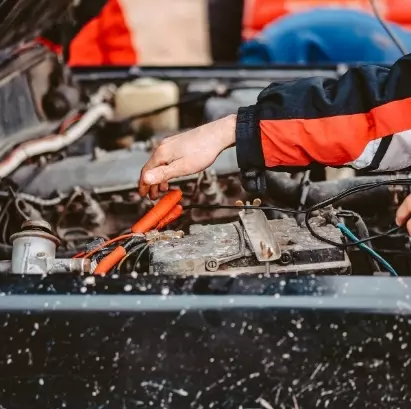Have you ever heard that dreaded click when starting your car? It’s when you realize your car won’t start because your battery is flat and it’s raining. So can you jumpstart a car in the rain? Yes, you can quickly jump start your car in the rain because there might be inadequate voltage in the car’s electrical system that might lead to electrocution.
When the cables are properly insulated, then jumpstarting your car cannot be that dangerous. Do not expose your car’s battery to the rain because it can cause corrosion, reducing its life duration. And clean the bluish-white things around the battery due to exposure to moisture.
There are situations that you won’t be able to avoid when it comes to jumpstarting your car. So you have to be very careful during this process. It is not appropriate to jumpstart your car in the rain, but you have to consider necessary precautions.
You should be very cautious about getting electrocuted and any other anticipated risks. But ask yourself this question, is it safe to jumpstart a car in the rain?
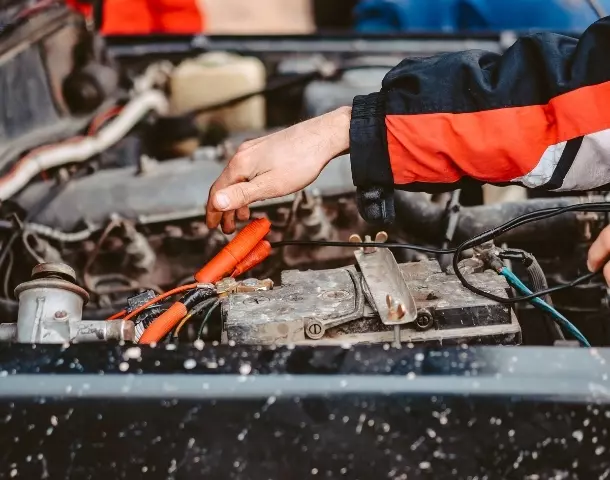
Precautions of Jumpstarting a Car in the Rain
It is common knowledge that water is a very good conductor of electricity. The electric system of most cars runs on 12V DC while 24V for big trucks. And, the amperage of the car battery is between 46 Ah to 50Ah. Therefore, the voltage and current range are safe for you to jump your car without getting electrocuted.
Technically, human beings can resist approximately 10000 ohms that is almost 0.012 amps for a 12V car, if you do the maths correctly. This is a negligible amount, and it cannot affect you while jumpstarting your car.
So is it safe to jumpstart a car in the rain? Although it is not best to jumpstart your car in the rain, it is possible as long as you adhere to some simple precautions:
- First, the most important thing to consider is your safety. You must wear gloves, and use an umbrella to protect yourself, battery, some sensitive electronics and innards of the car.
- Ensure that the cables are in good condition and properly connected to the right terminals. Avoid touching both battery terminals simultaneously. Even though the car’s battery voltage is 12V, it is a direct current (DC) voltage, so you should be very careful.
- The roads are slick when it is raining, so you should be mindful of other drivers too. Therefore, you need to watch out for traffic because you will get in and out of your car when jump starting it.
- Check for any existing damages: If there is any damage on either the batteries or jump leads, don’t risk the attempt of jumpstarting your car.
- In case you are wearing any metal jewellery, please remove them and ensure that no metal touches the battery terminals.
How to Safely Jumpstart a Car in the Rain
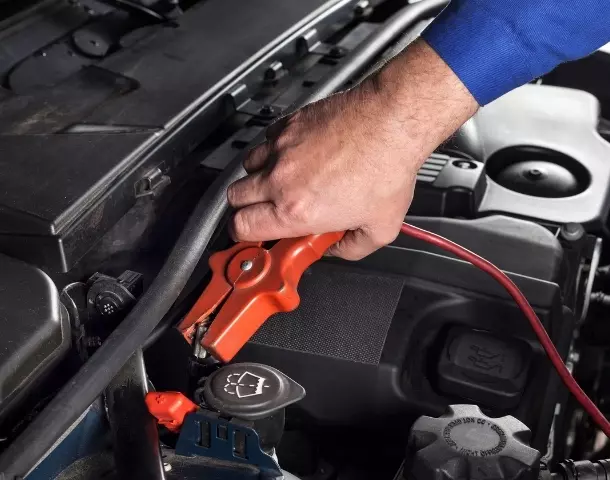
It is not dangerous to jumpstart your car in the rain, but you should follow a safe and secure process. Understanding how to jumpstart your car can help you in a dire situation. But first, what are the requirements for jumpstarting your car in the rain:
- Two vehicles
- Jump starter
- Jumper cables
- Extra battery
- Covering such as umbrella
Now that you know the things required to jump your car, follow steps below during rain:
Preparations
Check the locations of the cars since some jump leads are a few meters long. Move the running vehicles close to bring the battery closer together. The next thing to do is to check for any damages to the cables. Also, check the insulators for cuts and tears. And ensure that the clamps and cables are firmly attached.
Read the Car Manual
The car manual has a jumpstarting section. Please read it carefully and strictly follow the guidelines to avoid any damage that might arise.
Turn-off all Electrical Items
You should ensure that all unnecessary electrical devices are completely turned-off in both vehicles, such as radio, lights, and windshield wipers. Doing so enables you to accumulate enough power that should be transferred to the flat battery.
Bring Out the Jumper Cables
Remove the jumper cables so that you begin the process of jumpstarting your vehicle. You should always carry one for such kinds of emergencies. If you don’t have one, ask for someone to assist you with it.
Find the Location of the Battery
Check where the batteries are located on both cars. Most vehicles have their battery located in the same place, especially the hood, so make sure you know. Determining the location of the battery is essential because it enables you to reach them quickly with cables. Remember it is raining, so you must be careful with exposing the battery to the rain.
Watch out for your Safety
Most of the time, you stand between two vehicles packed facing each other. The best thing to do is ensure that they are correctly packed, and their batteries are close together. Most importantly, turn off the engines in both vehicles to prevent an unexpected tragedy. Lastly, make sure that the brakes are correctly set.
Connect the Clamps
All car batteries have both red and black terminals. The jumper cables are also coloured, either black or red, to avoid confusion. Hold both clamps separately to ensure that they don’t contact anything metal while connecting the cables.
Pay close attention to the order of connecting the jumper cables. Black is for negative, while red is for positive. Connect the red clamp to the positive terminal of a car with a good battery, then attach another clamp to the flat battery’s red terminal. Do the same for the other black clamp. You must ensure that you don’t cross-connect the cables because it can cause short-circuiting and is very disastrous.
Start the Car
First, start the car with a good battery and let the engine run for a while to add the required charge to the flat battery. After a short time, try starting the car with a flat battery. Assuming that the cables are correctly connected, your car should start automatically.
Disconnect the Cables
Now you can disconnect the cables, although in reverse order. Begin with the black clamp on your car, then black clamp on the car with a good battery. Repeat the same procedure while removing the red clamps.
After successfully jumpstarting the car with a flat battery, drive it and then allow it to idle for about 25 minutes. During this time, the alternator can recharge the battery. It also gives the flat battery adequate charge to start your car. Immediately attach the battery charger to recharge your car battery fully.
How to Charge Car Battery in the Rain
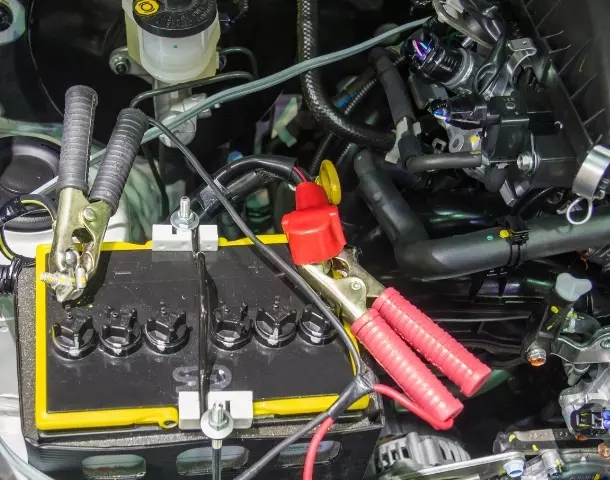
Now you understand the process of jumpstarting your car in the rain. On the contrary, what if your battery has a charging problem, and you are forced to charge it under rainy weather conditions?
In this case, the car battery cannot work, so you have to recharge it, using only a battery charger. To successfully charge your car battery, you need to follow the steps below:
- First, have the two vehicles packed beside the road facing each other, so that you can easily use the jumper cables.
- Turn off all the electrical systems before you try opening the car’s hood.
- Cover the hood with an umbrella to prevent you and the raindrops from conducting the electric charges.
- Connect the cables just the same way you did while jumpstarting your car
- Flip the switch of the battery charger and allow the battery to charge for approximately 25 minutes. Once the battery is fully charged, try starting the engine. Once the charging process is successful, then you are good to go.
What About Thunderstorms and Lightning?
Jumpstarting your car in the rain seems to be less dangerous. What about conducting the process in a severe thunderstorm? Both thunder and lightning pose serious dangers while jumpstarting your car. So what might be the biggest concern of jumping your car in a severe thunderstorm?
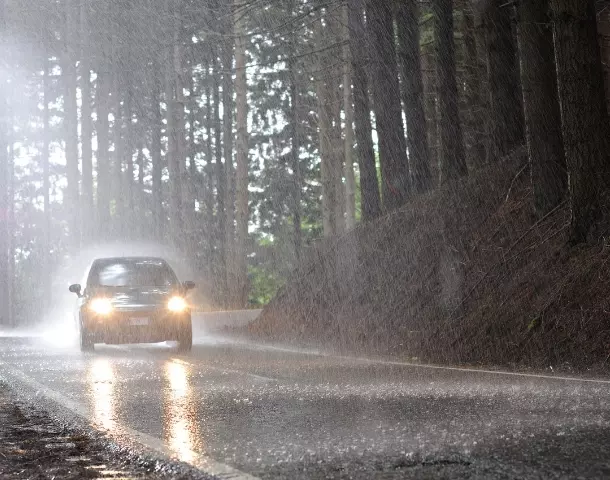
Low Visibility
A heavy downpour can reduce natural light, hence resulting in low visibility on the roads. Fortunately, most car batteries fail when the engine is turned off in designated locations such as driveways. So you are unlikely to jump your car in congested road traffic.
But, if you must jumpstart your car in limited visibility, make sure that both you and the vehicle are visible. The best action to take is to mount reflective cones on the road and turn on hazard lights of your car
It is also useful to have reflective clothes in your car because they come in handy during such circumstances. And, avoid wearing dark clothes, they make you invisible during a thunderstorm. You can prevent accidents if you follow these precautions.
Lightening
Lightning also complicates the safety of jumpstarting your car. So the best thing to do is to wait until the thunderstorm calms. There is no point in risking your life, but if you must proceed with the jumpstarting process, there are some things you must know.
Most people think that rubber in your car tires is what is protecting you from the lightning strike; that’s a myth. The metal on the roof and sides of the vehicle is what keeps you safe. A Faraday cage is created around you by these metallic frames.
The frame also protects the interior of your car from electricity. Therefore, the voltage goes around your car into the ground. You should avoid touching the metallic part of the jumper cables during lightning, because you can be short circuited.
Frequently Asked Questions (FAQs)
Is it safe to use jumper-cables on a wet car battery?
Yes, it is safe to use jumper-cables on wet batteries. But first, you should remove excess water from the battery before trying to connect the jumper cables, and try to prevent the battery from getting wet. This is because some delicate electronics in the engine compartment should not be in contact with water. The best alternative is to use an umbrella to keep things dry.
How long should it take to jumpstart a car?
If you have the right cables and are correctly connected, it should take about 5-10 minutes to jumpstart your car.
What can happen if I cross the cables?
Connecting a black terminal to a red terminal can lead to short-circuiting. Electrical currents flow through the wires, creating a massive amount of gas that can cause a flare-up. You must be very keen while connecting the cables to your car battery.
Is it appropriate to use wet jumper cables?
Once again, yes, you can use wet jumper cables to jumpstart your car. But make sure you dry them first before storing them. Most of the jumper cables are coated with rubber preventing the penetration of water.
You should concern yourself with the exposed metallic area, so don’t attempt to touch it. If the clamps are stored wet, they can start to erode, and they won’t function properly. So if you must use the wet jumper cables, dry them first then store them in a cool dry place for future use.
I jump started someone’s car, and now mine won’t start; what might be the problem?
If your car engine is starting, then the battery is considered to be okay. Try charging your battery using a battery charger. If the car doesn’t start, you might have damaged an electronic gadget in your vehicle. You need to call your trusted mechanic to check what the problem might be.
Conclusion
Provided you follow the steps we have highlighted above, jumpstarting your car battery can be a safe process. The car batteries run on a low voltage of 12V, so you cannot be electrocuted while jumpstarting your car in the rain. Also, to increase your safety, ensure you wear reflective clothes during severe weather conditions such as thunderstorms and lightning for your visibility and car. So what do you think, can you jumpstart a car in the rain?
